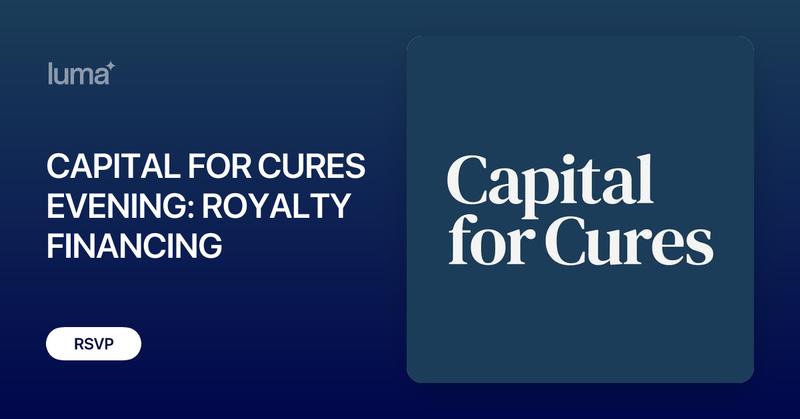The Return of Royalty

On 19 November, as the Jefferies London Healthcare Conference closes for the day, a different conversation begins. Registration for our evening session has passed 50 attendees, with more capital than companies in the room. The panel brings relevant experience to the table. Tony Hickson, Chief Business Officer at Cancer Research UK and Cancer Research Horizons, oversees one of Britain's largest biomedical research portfolios.
Bodo Marr, formerly Head of M&A and Treasury at MorphoSys, will add in his operational experience. Richard Gervase, partner at Mintz, works at the intersection of corporate securities and intellectual property law. The topic is royalty financing. The format is discussion followed by networking over small bites. The ratio of investors to companies suggests the market has moved. Register via the link below.

From tea party to royalty party
There is a certain historical irony at work here. Royalty, after all, was once a distinctly European export, one the Americans rejected with considerable enthusiasm. A tea party was thrown in Boston harbour in 1773, specifically to clarify the colonial position on the matter. No taxation without representation, no kings, no crowns, and certainly no royalties thank you very much. The revolutionaries won, the Constitution was written, and for two centuries America got along splendidly without anyone bowing to anyone else.
Yet here we are in 2025, and the Americans have reversed course. Not on monarchy (the Windsors can relax), but on royalties of the financial variety. U.S. institutional investors now lead the global charge in pharmaceutical royalty financing: pension funds, insurance portfolios, dedicated life-sciences royalty funds structuring deals that European innovators pioneered in their laboratory wings. The irony is complete: Europe invented the plumbing, America industrialised it, and now Europeans are buying American-designed systems to manage what they created. The Americans, it turns out, will tolerate royalties after all, so long as they yield 12% and come with downside protection.
The numbers tell the story. Pharmaceutical royalty financing reached approximately $14 billion in annual deal flow in 2024, more than double the $6-7 billion average from 2015-2019. Synthetic royalties, where companies create new revenue-sharing arrangements rather than selling existing license payments, are growing at 33% annually. The Revolution Medicines transaction in June 2025 established a new benchmark: up to $2 billion in total funding combining $1.25 billion in synthetic royalties with $750 million in debt. Royalty Pharma paid $885 million upfront in September 2025 to acquire royalty rights on Amgen's Imdelltra. These are not distressed financings. They are structured capital deployed by sophisticated investors who have concluded that forecasting drug revenues beats forecasting drug approvals.
Why the moment arrived
Three forces converged. First, equity exhaustion. The biotech XBI index remained flat for two years following a 45% decline from February 2021 peaks. Only 19 biotech companies went public in 2023 compared to 104 in 2021. More than 220 Nasdaq biotech companies now trade below net cash. For companies with promising assets but depleted runways, equity dilution at current prices is not merely expensive. It is existential. Better to share future revenues than surrender the company at fire-sale valuations.
Second, debt is expensive. Traditional term-loans for development-stage biotech carry rates around SOFR plus 5-6% because default risk is genuine. Royalty financing sidesteps fixed repayments: investors receive a share of product sales rather than obligated payments. If the drug fails, the investor gets nothing. If it succeeds, both parties benefit. The alignment is real, not rhetorical.
Third, investor sophistication increased. Early royalty deals were blunt: a flat percentage of sales, indefinitely. Modern deals embed caps (investor return limited to 1.9x-2.5x capital), step-down royalty tiers (rate falls after thresholds), carve-outs by indication or geography, combination instruments (royalty plus warrant or royalty plus convertible). Forecasting models now incorporate real-world evidence, competitive launch scenarios, pricing and reimbursement modelling. The rigour is comparable to debt underwriting. Someone has finally read the clinical trial protocols all the way through, not just the abstract and conclusion.
The mechanics matter
Royalty rates typically range from 4-10% of net sales for most transactions, though rates vary based on development stage and risk profile. The Revolution Medicines deal features tiered rates: 7.8% on annual sales below $2 billion, 2.4% on sales between $4-8 billion, and zero on sales above $8 billion over a 15-year term. The structure rewards early success and then gracefully exits. Elegant, really.
Payment caps are standard, with return multiples of 1.5x to 4x initial investment constituting the typical range. BridgeBio's $500 million royalty agreement in January 2024 includes a cap at 1.9x invested capital ($950 million), after which royalty obligations terminate. The investor gets paid, the company regains full economic control, everyone moves on. No perpetual entanglements, no messy breakups.
Deal structures vary. Traditional royalty monetisations involve the sale of an existing royalty stream from a license agreement, simple assignment of existing contractual payment obligations. Synthetic royalty transactions involve the sale of a percentage of future product revenue when no pre-existing license agreement exists, allowing companies that directly commercialise products to create new revenue-sharing arrangements while retaining ownership of IP and commercialisation rights. The latter are growing at 33% annually and now represent the fastest-growing segment. Synthetic royalties, it turns out, are neither synthetic nor particularly royal. They are simply revenue participations with better branding.
The players at the table
Royalty Pharma maintains commanding dominance with approximately 60% global market share, deploying $2.8 billion in 2024. In January 2025, the company announced it would acquire its external manager, a bit of corporate housekeeping expected to save over $100 million annually. Not exactly revolutionary, but tidy.
Healthcare Royalty Partners became even more interesting when KKR acquired a majority stake in July 2025. The firm had managed approximately $3 billion across 55+ products. KKR's rationale was straightforward: add biopharma royalties to its collection of 18 asset-based finance platforms. One stops collecting Monopoly properties eventually and starts collecting actual revenue streams.
Blackstone Life Sciences announced a new $5+ billion oversubscribed fund in January 2025, bringing assets under management past $8 billion. The firm's 85% Phase III success rate versus 48% industry average suggests either excellent judgment or excellent luck. Probably both. In April 2025 they sold Anthos Therapeutics to Novartis for $3.1 billion, which tends to impress limited partners.
XOMA Royalty Corporation took a different path, focusing on earlier-stage royalties. The company doubled its portfolio to 120+ assets in 2024, with revenue reaching $28.5 million versus $4.8 million in 2023. Not Royalty Pharma scale, but growing fast and willing to go where larger funds hesitate.
From writing to meeting
For six months we have been writing about royalty financing on p05.org. The analysis was useful, we hope. Capital for Cures has hosted events across Europe over the past two years. We have watched conversations turn into transactions. The November 19th evening represents a natural step: moving from commentary to convening. Over 50 people registered. More investors than companies. We are pleased with that.
Opening up the toolkit
Royalty financing still represents less than 5% of total biopharma capital formation. That leaves room for expansion. Not through hype, but through connection and structured dealflow. The tool works. The question is access.
For inquiries about the 2026 series, reach out to us. The market has momentum. What remains is connecting the right parties at the right time. For 2026 we are planning an event series across Europe, North America and Asia. Focused forums where the people deploying capital meet the people developing assets. We are looking for partners: institutional investors who see the asset class as part of their strategy, biotechs and pharmas willing to share structuring experiences, legal and advisory firms who understand the mechanics. The emphasis is on principals rather than service providers.

Member discussion